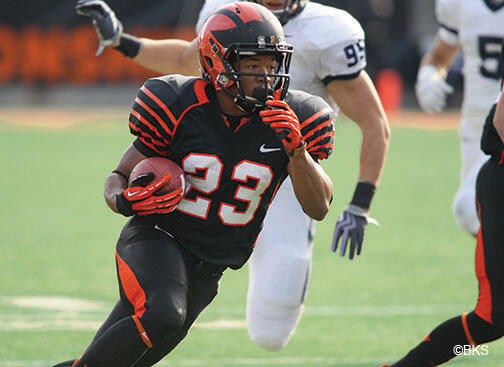Extra Point: Fueled by a Record-Setting Offense, Football Roars to an Ivy Championship
Princeton fans have come to expect a certain set of adjectives when TV announcers describe the men’s basketball team. Terms like “deliberate,” “unselfish,” and “cerebral” may be meant as compliments, but they carry a clear subtext: Princeton is the tortoise, slowly and steadily outsmarting the proverbial hare.
On Princeton football broadcasts this year, announcers embraced a new vocabulary — one that begins with “quick,” “creative,” and “athletic.” Practically overnight, coach Bob Surace ’90’s Tigers became the Ivy League exemplar of the fast-paced, no-huddle, spread-formation approach used by top-10 teams like Oregon and Baylor, setting a league scoring record with the multi-dimensional quarterback Quinn Epperly ’15 leading the way.
Epperly threw for three touchdowns and ran for another in Princeton’s 59–23 dismantling of Yale Nov. 16, earning the Tigers at least a share of the Ivy title for the first time since 2006 and a second straight Big Three bonfire. (Results from the Nov. 23 finale at Dartmouth were not available for this issue.)

The Tigers’ recent success has not come without some growing pains: Princeton’s offense took shape in 2010 and 2011, during back-to-back 1–9 seasons. Epperly saw his first action in the second of those campaigns, completing just 44 percent of his pass attempts as a freshman. In 2012, he improved his completion rate to a respectable 58 percent. Through nine games this year, he had completed 72 percent — including an NCAA-record 29 in a row against Cornell — while throwing for 23 touchdowns and just two interceptions.
Epperly’s upward trajectory underlines the secret of Princeton’s success: efficiency. Yes, the Tigers are fast and unpredictable, with alignments that include a three-quarterback backfield. Surace says that he loves going to meetings with offensive coordinator James Perry to hear what he’ll try next. But the team also has a remarkable knack for minimizing mistakes — and creating miscues on defense. Through nine games, Princeton led the Ivies in sacks (32) and interceptions (14).
Tiger fans understand that Ivy supremacy can be fleeting. The football team’s last two league championships, in 1995 and 2006, were followed by losing seasons. But this team appears to be built for a longer run. While Epperly has been remarkable, he’s merely on the top line of a long list of talented quarterbacks, running backs, and receivers. Of the 15 players who ran, threw, or caught the ball against Yale, only three are seniors.
Depth at the skill positions has been a hallmark of the Ivy’s recent powerhouse teams, Harvard and Penn. With this year’s results and a dozen starters returning next year, Princeton looks ready to join that top tier.













No responses yet